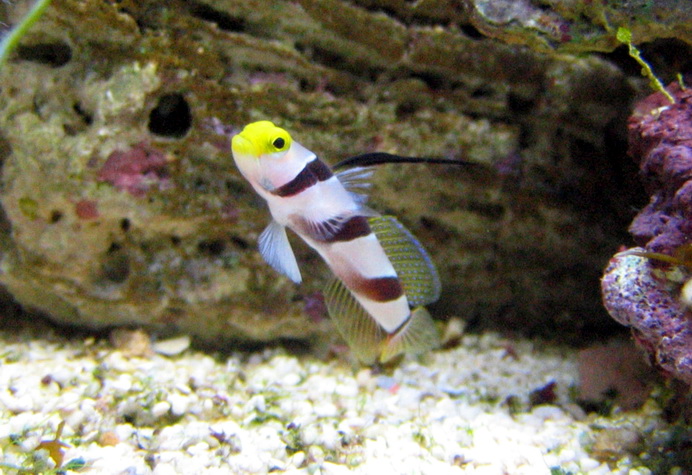Black-ray Goby (Stonogobiops nematodes) - Wiki Black-ray goby
From Wikipedia, the free encyclopedia
[Photo] Black-ray Goby Stonogobiops nematodes. Photo by Author: Me, Sam Davies, wikipedia username: sammydee.
The Black-ray Goby (Stonogobiops nematodes) is a species of marine goby and is a member of the family of High Fin Gobies. This type of goby is also sometimes attributed the common name "Shrimp Goby" or "Watchman Goby". This is due to the interesting symbiotic relationship that these gobies can form with Randall's pistol shrimp (Alpheus Randalli).
Physical Features
Adult fish can grow up to two inches in length, with the striking pointed dorsal fin becoming more raised and pronounced in adulthood. This elongated fin is the most obvious distinguishing feature between the black-ray goby and its close cousin, the yellow snout goby (S. Xanthorhinica). The fish are beautifully coloured with four diagonal brown stripes across a white body, and a distinctive yellow head. See accompanying photograph for reference.
It is almost impossible for anybody less than a specialized expert in the specific field of these types of fish to discern differences between males and females of the species.
Behaviour and compatibility
This fish is very docile and poses almost no threat to any other livestock inhabiting a typical marine aquarium. This passiveness makes it a perfect tankmate for delicate species like sea horses or pipefish. In fact, it is in reality quite shy, and when first introduced into an aquarium, may take up to several weeks before it is bold enough to leave its hiding place, or bolt hole. Whilst this fish can display aggression towards other tank inhabitants by opening its mouth and "yawning" at them, this is mostly show and the goby will quickly turn tail and hide if confronted.
The goby will spend most of its time hovering about two inches above its bolt hole, searching for scraps of food in the water column. If scared or startled, it will slowly retreat towards its hole. If the danger does not go away, it will dart inside at lightning speed.
Mated pairs of this fish are very rare and difficult to come by. Individual males may fight if placed in a tank smaller than about 50 gallons (~200 litres).
Relationship with Pistol shrimp
This goby, along with the others of its genus are renowned for their remarkable relationship with Randall's shrimp (or Candy-stripe pistol shrimp, Alpheus Randalli). This particular genus of goby does not associate with any other type of shrimp in the wild.
Behaviour
The shrimp spends the day digging a burrow in the sand in which both live. Burrows usually measure up to one inch in diameter, and can reach up to four feet in length. The goby has much better eyesight than the shrimp, and, as such, acts as the watchman for both of them, keeping an eye out of danger. The two animals maintain continuous contact, with the shrimp placing one of its antenna permanently on the goby's tail. When danger threatens, the goby will make continuous flicks of its tail, warning the shrimp that there is a predator nearby, and the shrimp will remain safely in the burrow. If the danger reaches a certain level, the goby will dart into the burrow after the shrimp.
At night, the goby will go into the burrow, and the shrimp will collapse the entrance to close it off. The burrow is exited the next day by the goby blasting its way out and collapsing the burrow. The shrimp then spends the next day laboriously rebuilding the entrance to the burrow. Both animals have also been known to share food with each other.
In the wild, most burrows are shared by male/female goby pairs, with their respective shrimp partners, and the female goby will use this burrow as a nesting site to lay her eggs.
The obvious benefits to both organisms of this symbiotic relationship make the interaction a form of mutualism. Here is an interesting example of this. The other fish is a dartfish (genus Ptereleotris). These fish are often found as unwelcome but ignored guests sharing the burrow with goby and shrimp.
Black-ray Goby in commercial trade
This goby is in high demand for home and hobby marine aquaria due to its beautiful colouration, docile nature and interesting interaction with symbiotic shrimp. This type of goby is the most common Stonogobiops species to show up in the marine trade, but is still quite rare.
Natural Environment
This goby is commonly found in the western Indo-pacific (Indonesia and the Philippines) inhabiting sandy bottoms and rocky outcrops at depths ranging from 60 to 100 feet.
http://en.wikipedia.org/wiki/Black-ray_goby
| The text in this page is based on the copyrighted Wikipedia article shown in above URL. It is used under the GNU Free Documentation License. You may redistribute it, verbatim or modified, providing that you comply with the terms of the GFDL. |
